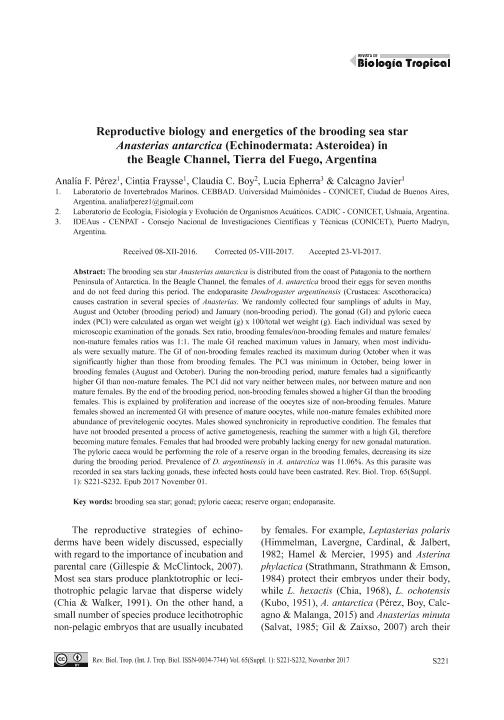Mostrar el registro sencillo del ítem
dc.contributor.author
Pérez, Analía Fernanda

dc.contributor.author
Fraysse, Cintia Pamela

dc.contributor.author
Boy, Claudia Clementina

dc.contributor.author
Epherra, Lucía

dc.contributor.author
Calcagno, Javier Ángel

dc.date.available
2018-07-25T19:42:52Z
dc.date.issued
2017-06
dc.identifier.citation
Pérez, Analía Fernanda; Fraysse, Cintia Pamela; Boy, Claudia Clementina; Epherra, Lucía; Calcagno, Javier Ángel; Reproductive biology and energetics of the brooding sea star anasterias antarctica (Echinodermata: Asteroidea) in the beagle channel, Tierra del Fuego, Argentina; Universidad de Costa Rica; Revista de Biología Tropical; 65; 1; 6-2017; S221-S232
dc.identifier.issn
0034-7744
dc.identifier.uri
http://hdl.handle.net/11336/53130
dc.description.abstract
The brooding sea star Anasterias antarctica is distributed from the coast of Patagonia to the northern Peninsula of Antarctica. In the Beagle Channel, the females of A. antarctica brood their eggs for seven months and do not feed during this period. The endoparasite Dendrogaster argentinensis (Crustacea: Ascothoracica) causes castration in several species of Anasterias. We randomly collected four samplings of adults in May, August and October (brooding period) and January (non-brooding period). The gonad (GI) and pyloric caeca index (PCI) were calculated as organ wet weight (g) x 100/total wet weight (g). Each individual was sexed by microscopic examination of the gonads. Sex ratio, brooding females/non-brooding females and mature females/ non-mature females ratios was 1:1. The male GI reached maximum values in January, when most individuals were sexually mature. The GI of non-brooding females reached its maximum during October when it was significantly higher than those from brooding females. The PCI was minimum in October, being lower in brooding females (August and October). During the non-brooding period, mature females had a significantly higher GI than non-mature females. The PCI did not vary neither between males, nor between mature and non mature females. By the end of the brooding period, non-brooding females showed a higher GI than the brooding females. This is explained by proliferation and increase of the oocytes size of non-brooding females. Mature females showed an incremented GI with presence of mature oocytes, while non-mature females exhibited more abundance of previtelogenic oocytes. Males showed synchronicity in reproductive condition. The females that have not brooded presented a process of active gametogenesis, reaching the summer with a high GI, therefore becoming mature females. Females that had brooded were probably lacking energy for new gonadal maturation. The pyloric caeca would be performing the role of a reserve organ in the brooding females, decreasing its size during the brooding period. Prevalence of D. argentinensis in A. antarctica was 11.06%. As this parasite was recorded in sea stars lacking gonads, these infected hosts could have been castrated.
dc.format
application/pdf
dc.language.iso
eng
dc.publisher
Universidad de Costa Rica
dc.rights
info:eu-repo/semantics/openAccess
dc.rights.uri
https://creativecommons.org/licenses/by-nc-sa/2.5/ar/
dc.subject
Brooding Sea Star
dc.subject
Endoparasite
dc.subject
Gonad
dc.subject
Pyloric Caeca
dc.subject
Reserve Organ
dc.subject.classification
Otras Ciencias Biológicas

dc.subject.classification
Ciencias Biológicas

dc.subject.classification
CIENCIAS NATURALES Y EXACTAS

dc.title
Reproductive biology and energetics of the brooding sea star anasterias antarctica (Echinodermata: Asteroidea) in the beagle channel, Tierra del Fuego, Argentina
dc.type
info:eu-repo/semantics/article
dc.type
info:ar-repo/semantics/artículo
dc.type
info:eu-repo/semantics/publishedVersion
dc.date.updated
2018-06-28T16:32:29Z
dc.journal.volume
65
dc.journal.number
1
dc.journal.pagination
S221-S232
dc.journal.pais
Costa Rica

dc.journal.ciudad
Turrialba
dc.description.fil
Fil: Pérez, Analía Fernanda. Universidad Maimónides. Área de Investigaciones Biomédicas y Biotecnológicas. Centro de Estudios Biomédicos, Biotecnológicos, Ambientales y de Diagnóstico; Argentina
dc.description.fil
Fil: Fraysse, Cintia Pamela. Universidad Maimónides. Área de Investigaciones Biomédicas y Biotecnológicas. Centro de Estudios Biomédicos, Biotecnológicos, Ambientales y de Diagnóstico; Argentina
dc.description.fil
Fil: Boy, Claudia Clementina. Consejo Nacional de Investigaciones Científicas y Técnicas. Centro Austral de Investigaciones Científicas; Argentina
dc.description.fil
Fil: Epherra, Lucía. Consejo Nacional de Investigaciones Científicas y Técnicas. Centro Científico Tecnológico Conicet - Centro Nacional Patagónico. Instituto de Diversidad y Evolución Austral; Argentina
dc.description.fil
Fil: Calcagno, Javier Ángel. Universidad Maimónides. Área de Investigaciones Biomédicas y Biotecnológicas. Centro de Estudios Biomédicos, Biotecnológicos, Ambientales y de Diagnóstico; Argentina
dc.journal.title
Revista de Biología Tropical

dc.relation.alternativeid
info:eu-repo/semantics/altIdentifier/url/https://revistas.ucr.ac.cr/index.php/rbt/article/view/31690
dc.relation.alternativeid
info:eu-repo/semantics/altIdentifier/doi/https://doi.org/10.15517/rbt.v65i1%20-%201.31690
Archivos asociados
